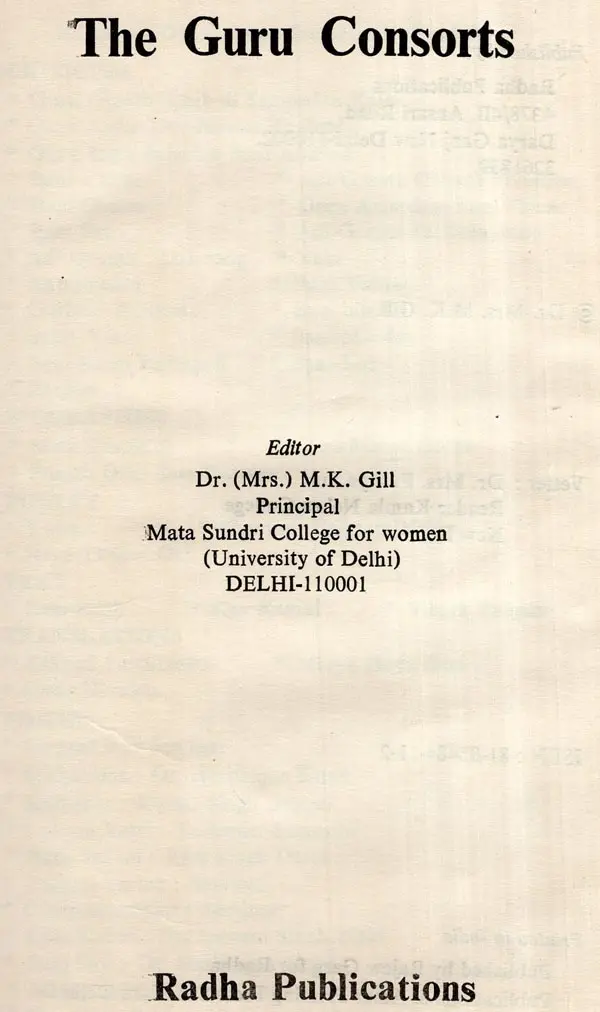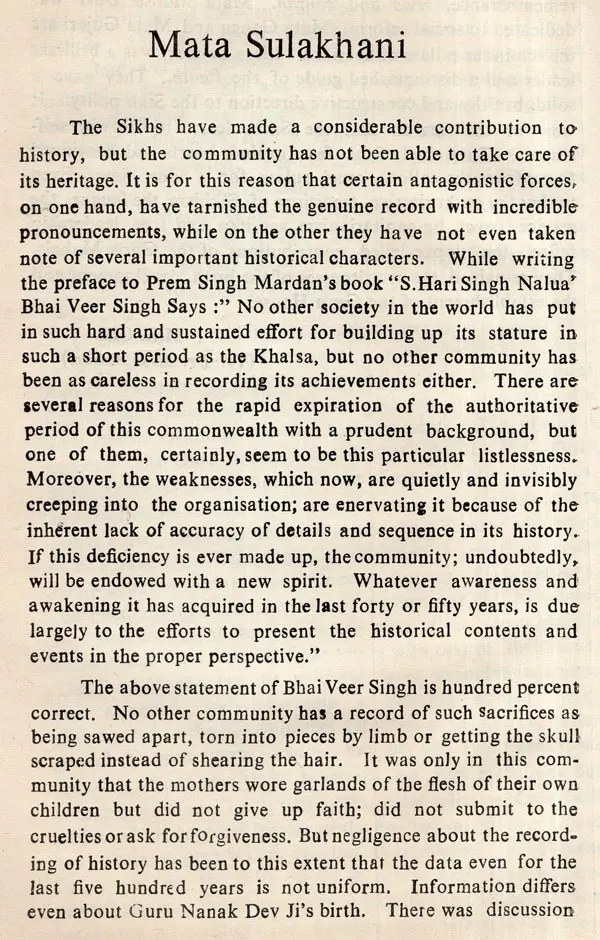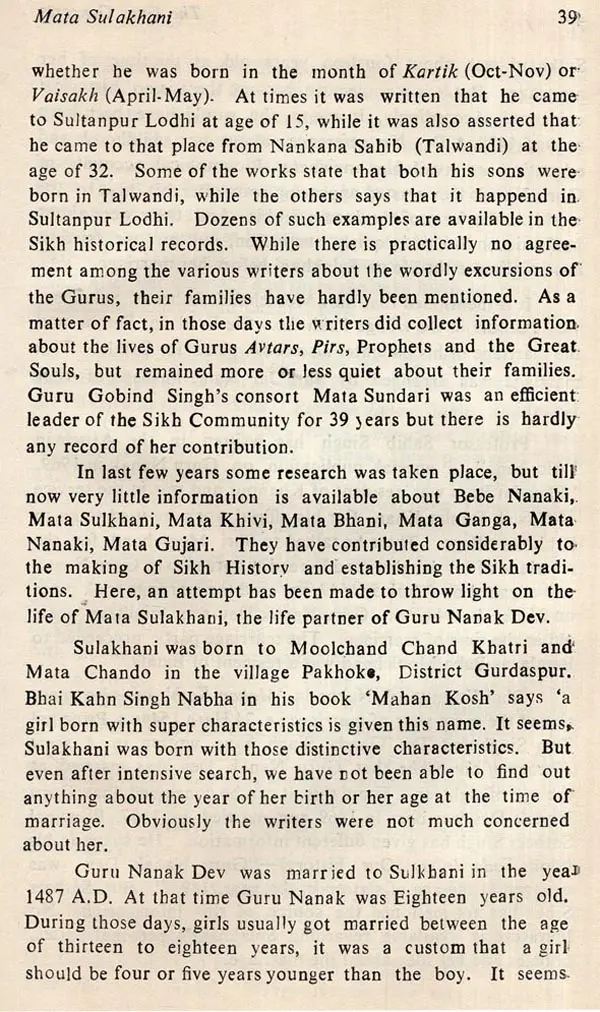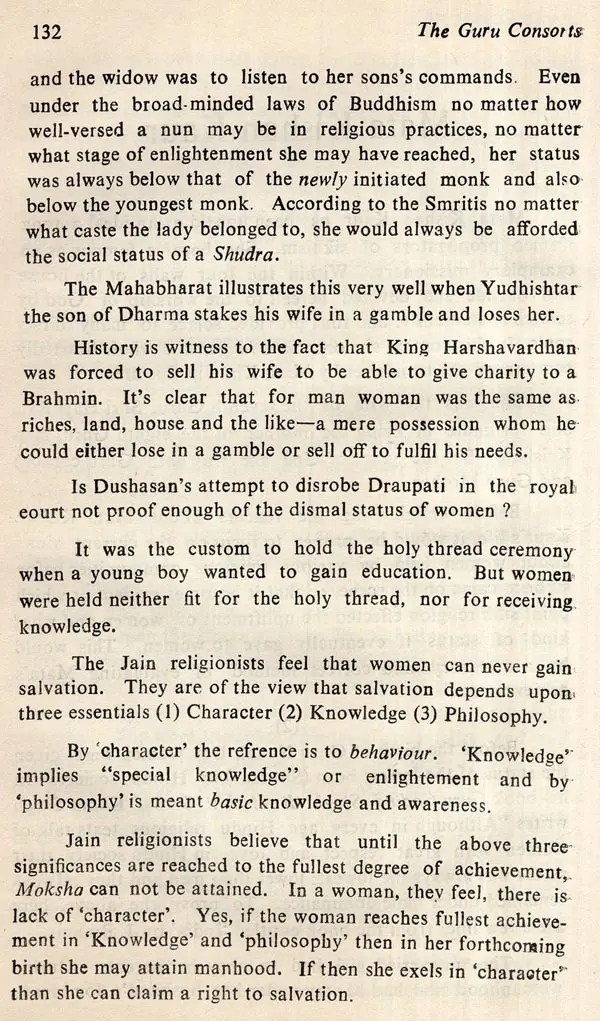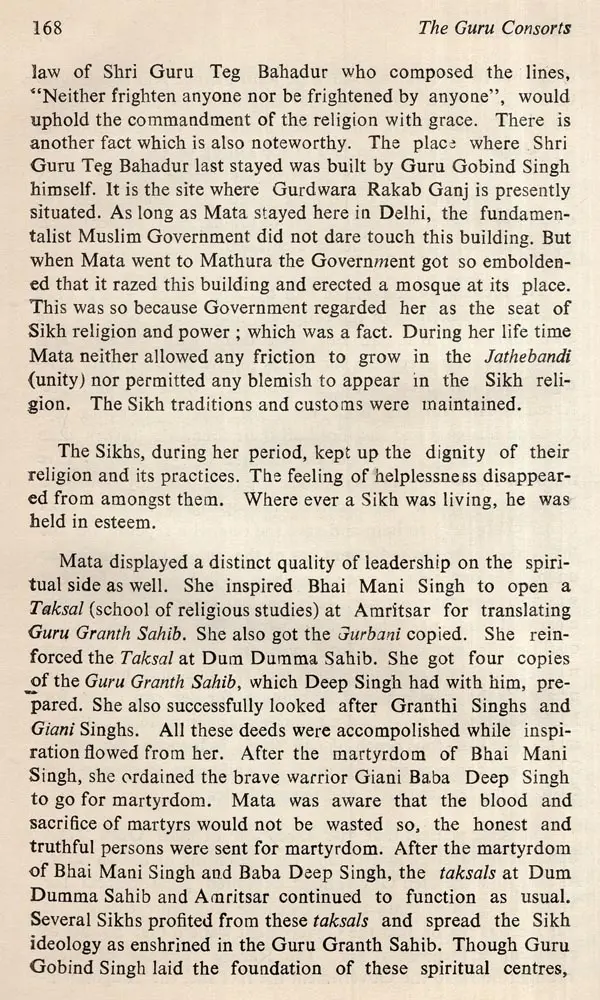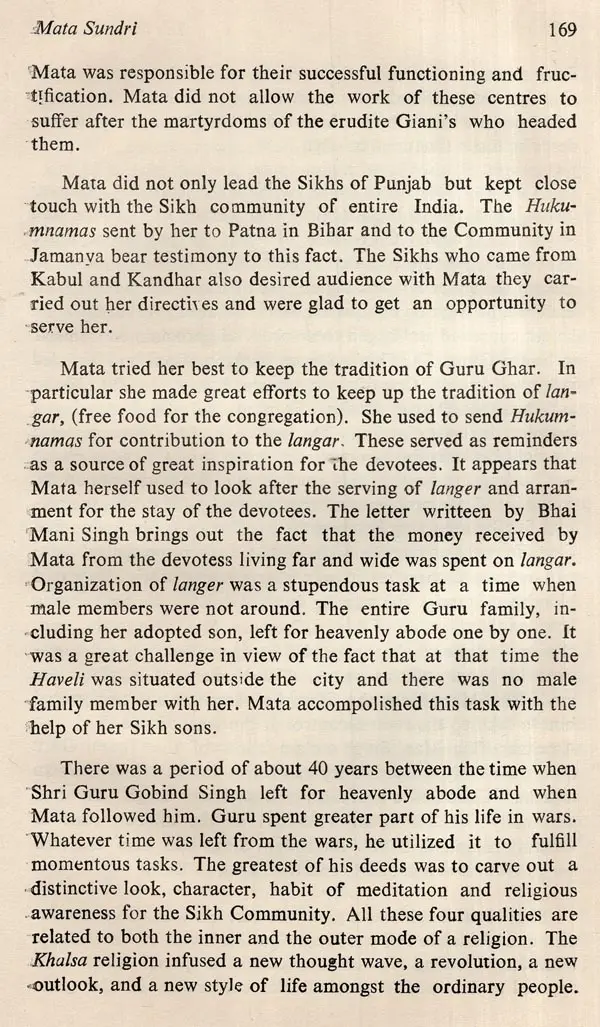
The Guru Consorts (An Old and Rare Book)
Book Specification
| Item Code: | UAH309 |
| Author: | M.K Gill |
| Publisher: | Radha Publications, Delhi |
| Language: | English |
| ISBN: | 8185484112 |
| Pages: | 226 |
| Cover: | HARDCOVER |
| Other Details | 9.00 X 6.00 inch |
| Weight | 360 gm |
Book Description
This book is of singular significance because it is dedicated to the personality, disposition and accomplishments of the Guru Consorts. Ideology of the Gurus is based on the Path of Positive Participation and it is difficult to understand and assimilate the basic features of this Ideology without comprehending and appreciating the role of the Guru Consorts who were the focal point in this Path. This book is a modest effort to come to grips with this problem.
Comparatively speaking, it is far more difficult to write the biographies of the Consorts than it is to record the history of the Gurus. It is not easy to find the material needed for this purpose because the Mothers patiently persevered in their duties without thought for recognition or reward. Whereas the Gurus were always perceptible to their followers as also their adversaries, their Consorts were simply out of their sphere of activities. Their style of work just did not entail direct link with historians or biographers.
The writers of essays in this compilation have worked fairly hard for the collection of data pertaining to the Guru Consorts. The Consorts worked in their own modest way, and were not accessible to the historians interested only in digging up facts. One has to knock at their doors with humilty, faith and an unsullied mind, with a view to searching out truth hidden below the surface of facts. This kind of work requires an altogether different kind of discipline and training. An historian weighs the available facts objectively and dispassionality; the chronicler of the Guru Consorts has to be guided to the truth by faith and reverence. These essays display such a blending of faith and truth.
How serene and composed was the demeanour of the Consort of Guru Nanak, the age-long traveller abroad. Or that of Guru Arjun, the attainer of martydom, or for that matter Guru Gobind Singh who was ever busy on the battle field? What role did the Consorts play in satisfying the minds of the sons of the Gurus when they were deprived of their inheritance? What was the ultimate aim of Mata Kheewi, who served 'Kheer cooked in clarified butter?
Apart from the reflections on the life styles of the people concerned, this book tries to answer the questions posed above, and many more which remained burking in the background and escaped the notice of the historians.
Associated with the name of Mata Sundri, the College occupies a special position in the city of Delhi. Here, girls of all religions, irrespective of the caste creed and class, as well as those from other countries come for studies, and offer obeisance to the Shrine of Mata Sundri without any kind of discrimmation, imposition or doubt in their minds. While these girls get modern education, they are also made aware of their traditional values.
The Guru House respects all religions, and holds every belief in esteem. Mata Sundari was. an epitome of all traditional values, and her Gurudwara gives its message to "all pious men to get together; and in order to remove all differences, spread a mat on the floor, sit down and contemplate on God's attributes".1
This was the way to create mental harmony. In this college the teachers are teachers and the students are students. Caste or religious discriminations are non-existant. All students get equal opportunities & facilities, Symbolic of a composite culture, the college celebrates the Day of Mata Sundri with great verve. The students sing devotional songs, and serve in the community kitchen. The staff helps with the service of utensils. The gardener prepares a banquet and presents it to the Holy Seat. The teaching staff decorates the palanquin. Everyone seems to belong to the family of the Mata. Each member of this family, the institution, is keenly aware of the exalted feeling of let us say. "liberty, fraternity and equality," of love aud unity. And these are the attributes which constitute the pillars of Mata Sundri College.
Twenty five years ago on this day, some generous people Preamt of establishing a college under the auspices of the Khalsa panth in Delhi. At that time Delhi Sikh Gurdware Prabhandak Committe and Shrimoni Prabhandak Committee Amritsar were complementary of each other and were the mainstay of the Sikh panth. It is felt that the institutional model of Amritsar was present in the subconscious minds of the people of Delhi. In Amritsar there is Khalsa College for men, and a Khalsa College for women too. In the capital, after the Khalsa College, the desire to open a women's college was natural for the Gurdwara Committee. It has been a known tradition of the khalsa panth that whenever the question of the building up of the nation, strengthening of Society, the unity of the community or the evolution of culture and civilisation has arisen, the men and the women have been given equal status. 'Singh and Kaur' are the first and foremost identity marks and balancing factors of the community.
By opening this college the management proved that the vital role of women cannot be ignored in the process of building up the character of the community. It was on the 16th July, the New Year day for the academic community of the University of Delhi, in 1967, when the members of the then Delhi Sikh Gurdwara Prabhandak Committce, got a few temporary rooms constructed and started the Degree College. Among them the most prominent person was the Late Jathedar Santosh Singh. Now this college has reached the level where post graduate courses are offered in Punjabi, Sanskrit and Political Science. The departments of Mathematics, English, Hindi, Punjabi, Sanskrit, History, Psychology, Philosophy, Political Science and Commerce cater to the Honours Courses. B.A. pass course covers as many as fourteen subjects. The college started with about Two hundred and fifty students but now has a strength of more than two thousand and five hundred. There are about two hundred staff members inclusive of teaching and non teaching staff. At the begining only one teacher had a Ph.D. degree but today there are as many as forty three teachers having Ph.D,s to their credit and sixteen, the M.Phil. About eighty teachers are in readers grade and the college can stand any comparison with the other colleges of Delhi University.
The esteemed Ten Gurus are well known all over the World. The Gurus were certainly spiritual in temperament, but having adopted the path of indulgence, were house-holders as well. Ten Guru Mahals (consorts) played a unique role in the propagation and advancement of Sikh faith and provided it with a pragmatic appearance. The institution of Guru Mahals evolved side by side with the Gurus tradition. Each Guru Mahal imparted specific lustre to brighten up the colour and complexion of her own heritage. The Sikh historians have been largely interested in building up, promoting, and giving a definite turn to the biographical accounts of the Gurus, but have remained indifferent towards those of the Guru Mahals. This indifference can be due to many factors. But without getting involved in this issue. it would he appro priate enough to mention that the life history of the Guru Mahals is not well known in the Sikh World. This has resulted in some serious drawbacks.
(a) Guru Mahals were a significant part of the Sikh heritage, but this aspect was neglected.
(b) That said prospect of Sikhism which, in comparison with the other religions of the World was solid, vigorous and healthy, could not come to the fore-front.
(c) In the context of the Indian Women World, the character and the distinctive contribution of the Guru Mahals in all activities of the Gurus remained in the back ground even though the Gurus themselves were always prominent in the current affairs.
Obviously, the physiognomy of the Sikh religion, which socially speaking is different in its presentation, has not been able to manifest itself in an effective and constructive manner. Guru Nanak Dev was born in 1469 A.D., and Guru Gobind Singh left for the heavenly abode in 1708; which means that the age of the Guru tradition is about Two hundred and Forty years. The institution of the Guru Mahals runs parallel to the Guru tradition.
At this point it seems proper to note that after the Tenth Guru, the Sikhs, for a long time, were a prey to intense cruelty and brutality. The historians call this period, the Blind Age. Sikhs, the victims of the holocaust went and hid themselves in the jungles and desolations. In such a dark period the controversies are bound to arise in the historical events and the time sequence, dates, years and places. But the worst outcome of all that was the appearance of lacunas, doubts and misunderstandings in the recorded details. More over the women occupied a secondary place in the male dominated society, so the Guru Mahals could not be considered important enough by the Sikh historians. But this. would by a questionable statement. It would have to be checked whether the reason for the lack of description about the Guru Mahals was the secondary place accorded to women in the social system of those days or simply, the nonavailability of the necessary detail to the contemporary historians. To me the later part of explanation seems to be more substantial. In a sense the social order of the Sikhs has been radically different from the contemporary society in general. The Gurus not only tried to ameliorate the position of women, they also set examples for paying genuine regard to women. The value system and the ideals in the Sikh religion. to-day are the same which the Guru Mahals had earned through hard labour and then lived with them. With their thought, word and deed, they strengthened the faith for the Guru Mission in the hearts of the emerging community. Another point: Though the information about the Guru. Mahals is scanty in the Sikh Chronicles, the Gurus themselves. have shown great regard and given an equal status to their lives. So, it is the attitude of the Gurus towards women which becomes more important then the availability of material regarding the Guru Mahals. The Gurus gave equal share to their Mahals in all their activities. They did nothing in which their consorts were not equally involved. Obviously the Gurus had an egalitarian, balanced outlook, and the Guru Mahals enjoyed a great deal of respect and regard in their time. They too give ample proof of their efficiency, and co-operated fully in all the undertakings of Gurus.
When Guru Nanak Dev talked about the improvement of the Status of women in Asa di Var (a long composition). He gave singular honour to his sister Bebe Nanaki to become his first woman disciple, and accepting his path, the first to adopt Sikhism. This was a great tribute to women by Guru Nanak Dev. It was Bebe Nanaki herself who understood and recognised the musical talent of her brother and bought him a rabab (a stringed musical instrument). Today, Kirtan i.e. (recitation of hymns in congregation) is the nerve centre of Sikhism. But it goes without saying that the idea of depicting devotion for God in musical notes was due to the inspiration given by Bebe Nanaki. It is since then that Kirtan became a norm in musical mode. Even now Kirtan enjoys a priority in the Guru House. Not only this, Guru Nanak made it essential for the conception of Bani to be musical. So, all the hymns in Guru Granth Sahib had to be according to the Raga compositions.
